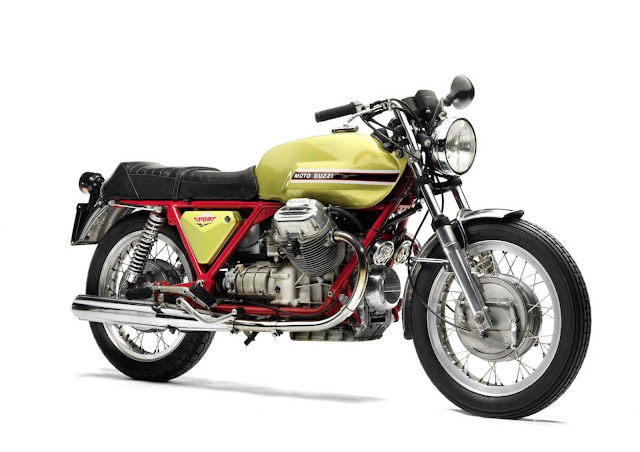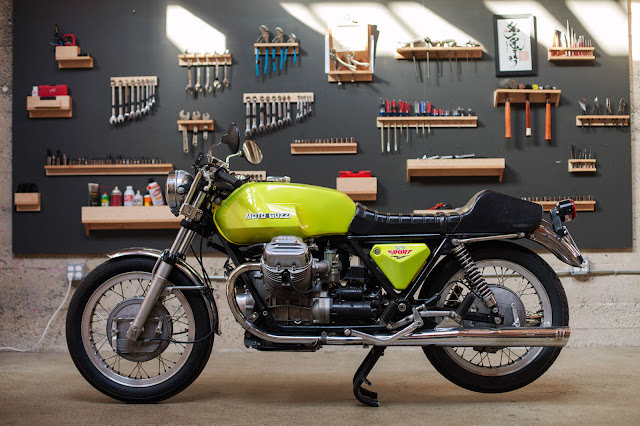Moto Guzzi V7 Sport
This immaculate, 1973 model V7 Sport was one of the last of fewer than 4000 that were built before production was stopped towards the end of that year. All had the model’s distinctive lime green paintwork and big twinleading-shoe front drum brake. Neat details included an inspection light, under the seat, that came on when the seat was raised.
The stylish, charismatic and impressively rapid V7 Sport was the bike with which Moto Guzzi established a reputation for performance that would last through the 1970s and beyond. The lime green Sport had a capacity of 748cc and was aptly named, as it was the first truly sporting model to be built using Guzzi’s distinctive 90-degree transverse V-twin engine.
Guzzi’s air-cooled, pushrod-operated V-twin motor had unlikely origins, as it had been developed for the Italian military in the late 1950s to power a tractor-like machine called the 3x3. The shaft-drive engine had then been adapted to power Guzzi’s first V-twin bike, the 704cc V7 tourer, which had been launched in 1967. Two year later the engine had been enlarged to 757cc and used for the V7 Special, known as the Ambassador in America.
This model, too, was a softly tuned tourer but Guzzi’s management could see its potential. In 1969, tuned and lightened V7s were ridden to a string of world speed records at Monza racetrack, including hour and 100km records at over 135mph (217km/h). Encouraged by this, the firm from Mandello del Lario began development of a purpose-built sportster.
Powerful engine
The V7’s 757cc engine was reduced in capacity to 748cc, to allow entry in 750cc races, and tuned with a hotter camshaft, increased compression ratio, lighter valvegear and conrods, new ignition system and unfiltered 30mm Dell’Orto carburettors. With a peak output at the crankshaft of 70bhp at 7000rpm (52bhp at the rear wheel), the Sport motor was among motorcycling’s most powerful, as well as considerably lighter than the old engine.
Another important change was the new engine’s alternator on the front end of the crankshaft, replacing the old generator in the Vee. This enabled Guzzi engineer Lino Tonti to design a lower frame with a steel backbone between the cylinders. On the first batch of about 150 Sports, assembled in Guzzi’s race department, the frame was painted red. Cycle parts were of high quality, including Guzzi forks with sealed damper units, Koni shocks plus a big twin-leading-shoe front drum brake.
The result was a stunning machine that combined aggressive looks with taut handling and a thrilling turn of speed - so much so that in the two years following its launch in 1971, the V7 Sport was arguably the world’s fastest production motorcycle. In 1972 Italian magazine Motociclismo timed the Sport at I25mph (201 km/h), faster than rivals including the Honda CB750, Kawasaki 750 H2, Laverda 750 SF and Ducati GT750. The magazine’s testers also lapped Monza quickest on the Guzzi.
On the road the Sport cruised smoothly and effortlessly at 90mph (I45km/h), and accelerated strongly from 4500rpm, although the motor lacked punch below that figure. High-speed stability was excellent, and cornering ability very good, with little adverse effect from the shaft final drive. The Sport was also raced successfully, finishing third in a 500km event at Monza on its debut in 1971, and also third at that year’s Bol d'Or at Le Mans. Moto Guzzi had arrived as a superbike manufacturer.
Updated Twin: the 750S3
Guzzi produced the V7 Sport until 1975, by which time it had been joined by alternative 750cc models. The 750S of 1974 was essentially a Sport with twin disc front brakes, plus black paintwork with diagonal stripes in red, orange or green. A year later came the 750S3, which combined similar styling with Guzzi's new brake system, which linked the two front and single rear discs. Although it looked superb and produced a claimed 72bhp, the S3 was slightly slower than the Sport, due to modifications including a milder camshaft and smaller carbs.
Updated Twin: the 750S3
Guzzi produced the V7 Sport until 1975, by which time it had been joined by alternative 750cc models. The 750S of 1974 was essentially a Sport with twin disc front brakes, plus black paintwork with diagonal stripes in red, orange or green. A year later came the 750S3, which combined similar styling with Guzzi's new brake system, which linked the two front and single rear discs. Although it looked superb and produced a claimed 72bhp, the S3 was slightly slower than the Sport, due to modifications including a milder camshaft and smaller carbs.
Guzzi’s transverse V-twin cylinders give a unique view from the front. ‘Swan-neck’clip-on handlebars could be slid up the forks to give a more upright riding position.
The Sport motor had reduced 748cc capacity tuned internals and a ne’w five-speed gearbox, plu s a Bosch alternator at the front of the crankshaft.
Moto Guzzi V7 Sport 1971
- Engine Longitudinally mounted 748 cc
- Transmission 5 speed, shaft drive
- Tyre front 3.25-18 with WM2 aluminium rim
- Oil Capacity 6 Imperial pints (approx 3.3 litres)
- Suspentuion Front: telescopic forks Rear: twin shocks adjustable for preload



















0 comments: